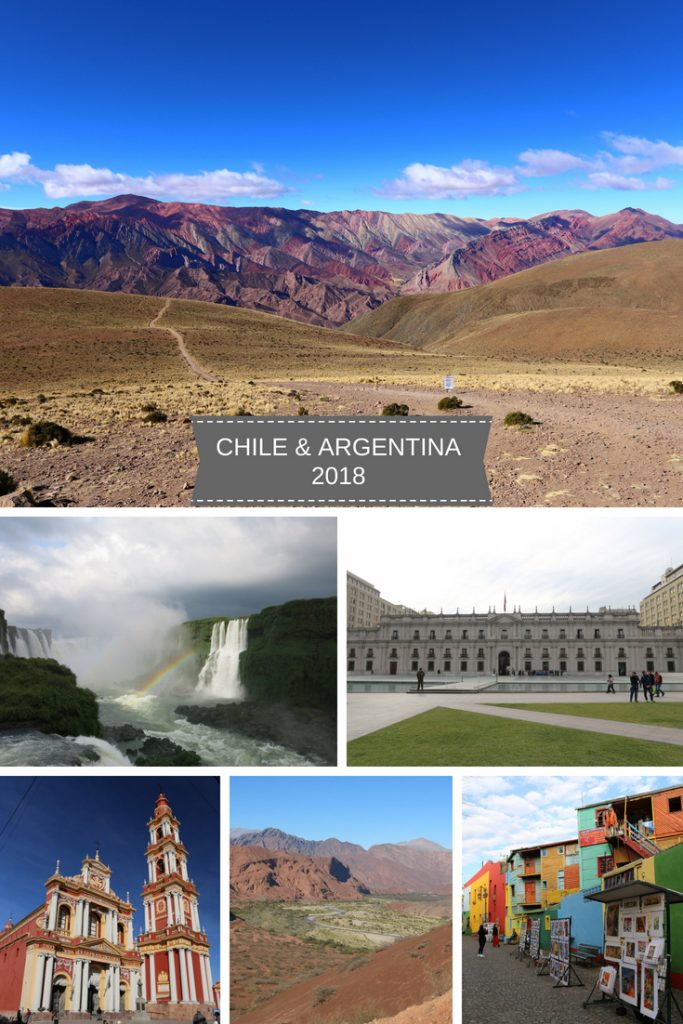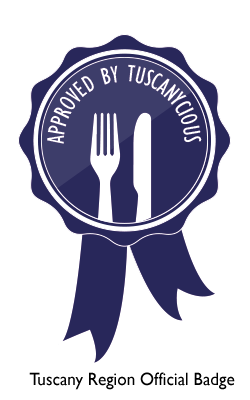My family and I have just returned from one of the most amazing trips ever: 3 weeks around Chile and Argentina. I had been dreaming about visiting these countries ever since I was 15. I wish I could say that was not long ago, but in all honesty, I cannot.
When we first booked our tickets for South America, we were planning to go to Peru, but then we changed our mind. This was going to be our very first trip to South America and even though my husband and I had already visited Central America when we were just married, travelling with kids makes things slightly different. When we sat down to think about what we really wanted, we agreed that travelling with 2 young kids among hordes of tourists at very high altitudes when we did not know how we (and, most importantly, the kids) would physically react to the lack of oxygen was not what we wanted.
We wanted a mix of adventure and relaxation. We wanted to see breathtaking scenery at our own pace and explore a quiet and not so touristy area of the world. Something similar to the beauty of Peru and Bolivia, but not so well known. We also wanted to teach our kids about the recent history of a part of Latin America and see some vibrant cities. We wanted to enjoy amazing food and wine and immerse ourselves in a total cultural experience. That’s how we came to choose our destination: the North West of Argentina has all these characteristics. We added Iguazu and Buenos Aires to the itinerary and a couple of days in Santiago de Chile which is the hub to South America when flying from Australia.
OUR ITINERARY
08/06/2018 Santiago de Chile (arrived at noon)
09/06/2018 Santiago de Chile
10/06/2018 Santiago de Chile – Buenos Aires – Iguazu
11/06/2018 Iguazu
12/06/2018 Iguazu
13/06/2018 Iguazu – Salta
14/06/2018 Salta – Salinas Grandes – Purmamarca
15/06/2018 Purmamarca – Quebrada de Humahuaca – Purmamarca
16/06/2018 Purmamarca – Salta
17/06/2018 Salta – Cachi – Molinos
18/06/2018 Molinos – Cafayate
19/06/2018 Cafayate
20/06/2018 Cafayate – Salta
21/06/2018 Salta – Buenos Aires
22/06/2018 Buenos Aires
23/06/2018 Buenos Aires
24/06/2018 Buenos Aires
25/06/2018 Buenos Aires
26/06/2018 Buenos Aires – Santiago de Chile
27/06/2018 Santiago de Chile – Sydney
Video – Highlights
Before going into more details about our journey, let me give you some practical information that will help you plan your own trip.
HOTEL BOOKINGS
There are many sites where you can easily book your hotels in Japan, like Booking.com or HotelsCombined. I usually prefer to book directly with the hotels via email, so that’s what I have done this time as well.
To decide on the hotels to book, I often read reviews on Tripadvisor and besides reading what other travellers have to say, I look at the pictures they took, as those don’t lie and I can get a better idea about the place. Always ensure that your booking can be cancelled any time before your stay, just in case…
INTERNET
All the hotels we stayed in had free wi-fi. So, keep that in mind when you decide whether or not you need Internet 24/7. We were going to rent a car and we wanted to use our mobile as a navigator, so we decided to get a SIM for my mobile.
We got an Argentine SIM from Personal at the airport (Aeroparque Jorge Newbery). It was 3GB and it lasted 1 month. It cost about 450 ARP and we always had a very good connection. We were also able to use my mobile as a hotspot for our other devices, so we were quite happy with this solution.
MONEY
We exchange our money into pesos in Australia before leaving the country. We did that because it was the first time we went and we had read a lot about the risks of receiving counterfeited notes etc. However, the rate we got was far worse than what we could have got locally. I think the next time we visit, we will exchange there.
CAR RENTAL
We rented a car for a week to have the freedom to travel around at our own pace in the North West of Argentina. My husband does not drive a manual car, so we were restricted in our choice of rental company and type of car, but if you drive a manual car, then you can have your pick. You can find all the major (and a few local) companies in Salta, both at the airport and downtown. We went with Localiza, which was the only company we knew had automatic vehicles available.
The car we rented was a Chevrolet Prisma sedan. It was comfortable enough for the four of us and all our luggage (3 medium trolleys and a small one). Having said that, after finding out the condition of some of the roads we drove on, we wished we could have rented a pick-up or an SUV… anything with bigger wheels! The risk of a flat tyre is very high, so be prepared to know how to change a tyre.
Luckily, it did not happen to us, but I think that was pure luck and the fact that the people at Localiza had already given us the car with a hole in one of the tyres… and 2 flat tyres in a trip would have been way too many. Yep, you read that right. We had noticed that one of the tyres was not as full as the others, but we were told that the car had been thoroughly checked and that it was best to have lower pressure on the gravel roads we were going to drive on. Well, the next morning, just before leaving Salta to start our road trip, the tyre was completely flat! We had to find a gomeria (mark this term which means tyre workshop, in case you need it!) to have the tyre fixed. Luckily I speak Spanish, so we had no problems and 30 minutes later (and 150 ARP lighter), we were on our way.
The car cost 11,000 ARP for 7 days, including the extra driver, and the insurance was another 160 ARP per day with the lowest excess/deductible possible. Gas was about 30 ARP per litre.
All things considered, if I could choose another rental, I would. But finding an automatic car is really hard, so I am not sure that would be an option.
TAXI
We never really took a “proper” taxi, as we either had the car or we used public transport to visit the big cities. However, there were a couple of exceptions.
From the airport in Santiago de Chile we used a private transfer to get to our accommodation in downtown Santiago. We used Transvip and their stand is at the airport just after you retrieve your luggage and BEFORE getting out in the open air. It cost 26,400 CLP each way but if you book a return transfer you get 10% off. They have different options, including a shared transfer that would be cheaper for 1 or 2 people. We used this service both times we were in town, even though once they were 45 minutes late to pick us up… which is never good when you have to catch a flight. Luckily we had some extra time, so we didn’t have any problem, but keep that in mind.
From the airport in Buenos Aires (Aeroparque) we used a remis to get to our accommodation in Puerto Madero. We used Transfer Express, but there are a few different stands. Check their prices before choosing. It cost about 450 ARP each way. The stands are just after you retrieve your luggage and BEFORE getting out in the open air. I personally loved this system… you pay at the counter and they give you a voucher to present to the driver, so you know the price is fixed and you don’t have to worry about anything.
From the airport in Puerto Iguazu we got a private transfer to get to our accommodation. The transfer was organised through our hotel, however, Leonel – our very professional and friendly driver from Aguar – also works on his own. We were very happy to avail of his services also the following days to go to the Iguazu Falls, both on the Argentine and on the Brazilian sides. Passing the border was a breeze thanks to Leonel and he was always on time. Not only, conversation was a pleasure as well! You can contact him here: Leonel Hugo Suarez, WhatsApp +5493757610153, Email: [email protected]
PUBLIC TRANSPORT
Both in Santiago and Buenos Aires we walked as much as we could. We like to walk around and see the cities at a leisurely pace. When we had to get to farther places, however, we used busses. In fact, even if both cities have a subway system, we preferred the bus, so we could still look around.
To ride the bus (or subway) in Santiago, you need to buy a BIP! Card. You can get it at any train station and it costs 1500 CLP. You then charge it with as much money as you like. Each bus ride costs 660 CLP. You don’t need 1 card per person, you can simply use one and scan it once per person. Kids below 9 years old do not pay. In theory, you enter the bus from the front door and you scan your BIP! Card in the machine, then pass from the turnstile and move towards the centre/end of the bus – from where you get down. I say in theory, as we saw many people simply entering from the middle/end doors without paying.
To ride the bus (or subway) in Buenos Aires, you need to buy a SUBE Card. You can get it at any kiosk (including at Aeroparque) and it costs 25 ARP. You then charge it with as much money as you like. Each bus ride costs 10.95 ARP. You don’t need 1 card per person, you can simply use one and scan it once per person. You enter the bus from the front door, tell the driver where you are going so he can calculate the fare, and you scan your SUBE Card in the machine. Easy.

INTERCONTINENTAL FLIGHTS
We chose to fly Qantas to Santiago de Chile for two reasons: we got a great offer to use some of our frequent flyer points (we got 4 tickets for the “price” of 3) and they have a direct flight to Santiago. Anything to avoid a stop-over in Auckland. Don’t get me wrong, I have nothing against New Zealand, but a stop-over would add more time to an already way-too-long trip AND it would make buying any liquid duty-free items impossible (yeah, you’d have to re-check them in!!!).
Unfortunately, most of the flying is done during the day – both ways, which makes sleeping and resting hard.
I have always flown very well with Qantas, but this time my experience was mediocre at best. On our way to Chile, the plane was really old… so old that it still had ashtrays!!! And the tray tables wouldn’t even hook properly to the seats in front… so much so that it did bang my hands hard a couple of times. The entertainment system wasn’t the best either with not much choice of movies. The fact that every time we fly Qantas to Japan with the same kind of aircraft, the plane is brand new left a bad taste in my mouth. It felt a bit like this part of the world was considered less… important.
On the way back to Australia instead, the plane was newer and the entertainment system had a better selection of movies (even though it had no itinerary map for some strange reason!), but the food service was appalling. Since having being diagnosed with IBS, I have to be very careful with what I eat. Qantas, however, does not have a food option that would cater even close to my dietary needs (like possibly a bland meal without onion and garlic), so I had chosen a vegan meal (I am also lactose intolerant) in the hope of being able to eat something of it. Well… you won’t believe this, but the vegan meal came with… CHEESE. Oh yeah! And I wasn’t the only one who noticed… The funny thing is, I had ordered a vegan meal only to avoid cheese… It was a 14-hour long flight and to get that wrong was simply unacceptable. Luckily, I had packed my own food, or I would have starved! Thanks, Qantas!
FLIGHTS WITHIN SOUTH AMERICA
Within South America, we flew mainly Latam, because they are part of One World like Qantas and we would get frequent flyer points. We had heard great things about them, however we were quite disappointed: old planes without ANY entertainment (even on international flights), delays and rescheduling without any kind of communication, and even a cancellation via email without further assistance – we had to call their call centre from Buenos Aires (in Spanish) and sort it out on our own with people who didn’t really know exactly what they were doing!
One of the reschedulings also obliged us to stay 5 hours at Buenos Aires airport (AEP) waiting for our connecting flight to Puerto Iguazu! Not fun!
The only time we flew Aerolineas Argentinas (well, their low-cost partner Austral actually), instead, we had a fantastic experience! And to think everyone had told us the contrary! The plane we took between Puerto Iguazu and Salta was brand new. We had our individual screen and a great selection of movies and TV shows! They even brought us snacks (all gluten-free!) and drinks and the flight was on time. Not a single issue. Next time, we will fly with them and save our money.

WHEN TO VISIT
Any time of the year! Just make sure to check when the local school holidays are and plan accordingly as those could be busy times.
We had chosen June because it was the ideal month to visit Peru, so we were happy to learn that even though it is winter (and cold!) in Argentina, it was still a great time to visit the areas we had in mind.
In fact, apart from a few overcast days in Iguazu and the first day in Purmamarca/Salinas Grandes, it never rained and the sun shone all the time. Temperatures drop at night though, so make sure to bring warm clothes if you visit in winter.
The best part about travelling in winter is the lack of crowds. In fact, that was probably what I loved the most: being able to wander around almost alone. In the Salta area, we only saw a few local tourists and only once we heard someone speak English. I got the impression that the area is still not as popular abroad as it is in Argentina and I am very glad we got to visit before its charms are discovered by a wider crowd. It felt genuine and unspoilt.

HOW TO PLAN YOUR ITINERARY
A trip to Chile and Argentina is very easy to organise on your own because there is a ton of information available on the web.
Here are the sites that I highly recommend you read when planning:
TripAdvisor – to find hotel and restaurant ratings. There are also great forums (Chile, Argentina) with friendly people who give very good advice.
Lonely Planet Thorntree – a good forum (Chile, Argentina).
Travel blogs to read other people’s experiences (google them and you will be amazed by how many there are!). I particularly loved He Needs Food for the beautiful photos.
Find images of places/cities/attractions to see what they really look like and if you’d like to see them.
Google Maps – useful for planning, but above all while there. We used the navigator part quite a bit to get from one place to the other.
I also have the Lonely Planet for both Chile and Argentina (Travel Guide) that I find very useful.
OUR JOURNEY
I am going to write a specific post/guide on each place with more details, however, what follows is a summary of our journey.
On the 8th of June, we flew Qantas from Sydney to Santiago de Chile. The flight left at 12:30 PM and it arrived at 11 AM on the same day, as we were “going back in time”. After collecting our luggage, we got a transfer from Transvip to our accommodation in downtown Santiago: Lastarria 43/61.
We left our stuff at our 2 bedroom apartment, went to get our BIP! Card from the nearby Universidad Catolica subway station, and went walking to La Moneda, which was only about 1 km away. What a moving experience to be finally there.
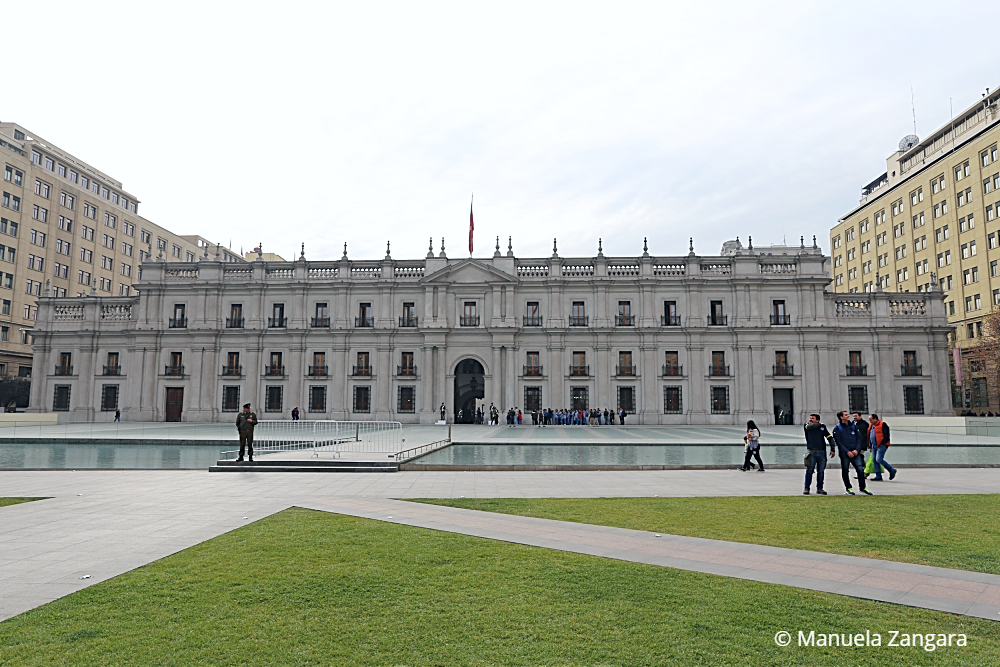
You may not know this, but I am a history buff, and this trip was filled with visits to historical places that hold a very important place in my heart. La Moneda was one of them.

And so was Londres 38, the place we visited next. It’s a building that was used as a clandestine detention and torture centre by the infamous DINA secret police during the Pinochet regime. The house is nestled among many other “normal” buildings and it feels surreal to think that so many people could be made “disappear” in the heart of the city.


After a very touching visit, we stopped at the nearby San Francisco church and then returned home. Too exhausted to go out for dinner, we had a quick snack in the room and went to sleep.
The following day (9th of June), we went to visit one of Pablo Neruda’s houses: la Chascona. It is such a beautiful house, full of the poet’s personal belongings. It feels like he may come out from one of the rooms at any time.


Then we took the funicular up Cerro San Cristobal from where you can see the whole city and the snow-capped Andes in the background.

Unfortunately, the weather was not great still, the view was impressive.

After a picnic lunch, we caught a bus to go to the Museum of Memory and Human Rights where you can learn a lot about the Pinochet coup and the terror he spread during his regime. It is a very touching visit that I recommend to everyone.

The following day (10th of June) we caught a 6:50 AM flight to Buenos Aires. As Latam had rescheduled our connecting flight from 12 PM to 3 PM, we had 5 hours at the airport. We got a local SIM card from Personal and our SUBE cards for the bus and had lunch. We rechecked-in our luggage and then decided to catch a bus in front of the airport to go to Parque de la Memoria (Remembrance Park), which is a 5-minute bus ride from Aeroparque Jorge Newbery.
Located along the Rio de la Plata, the park commemorates the victims of Argentina’s military dictatorship, where from 1976 to 1983, tens of thousands of civilians were killed and made disappear under governmental terrorism (desaparecidos). There are many sculptures in the park, including walls where the names of thousands of victims have been engraved.

It is located only 300 meters from the military airport from where the infamous “death flights” used to depart: victims of the state terrorism were taken up in flights and dropped into the ocean alive, never to be seen again.
Needless to say, it was a very moving visit.
Then we caught our flight to Iguazu and Leonel was waiting for us at the airport to take us to our hotel: Loi Suites, where we also had dinner.
The following day (11th of June), we visited the Argentine side of the Iguazu Falls. There is a lot to see on this side of the falls! We went immediately to see the Garganta del Diablo (Devil’s Throat), which is simply majestic. The amount of water it holds is impressive. You get completely wet even before you reach the viewing point!

Then we walked both on the lower path, from where you see the falls from the bottom. And the upper path, from where you see the falls from the top. We spent the whole day at the park!
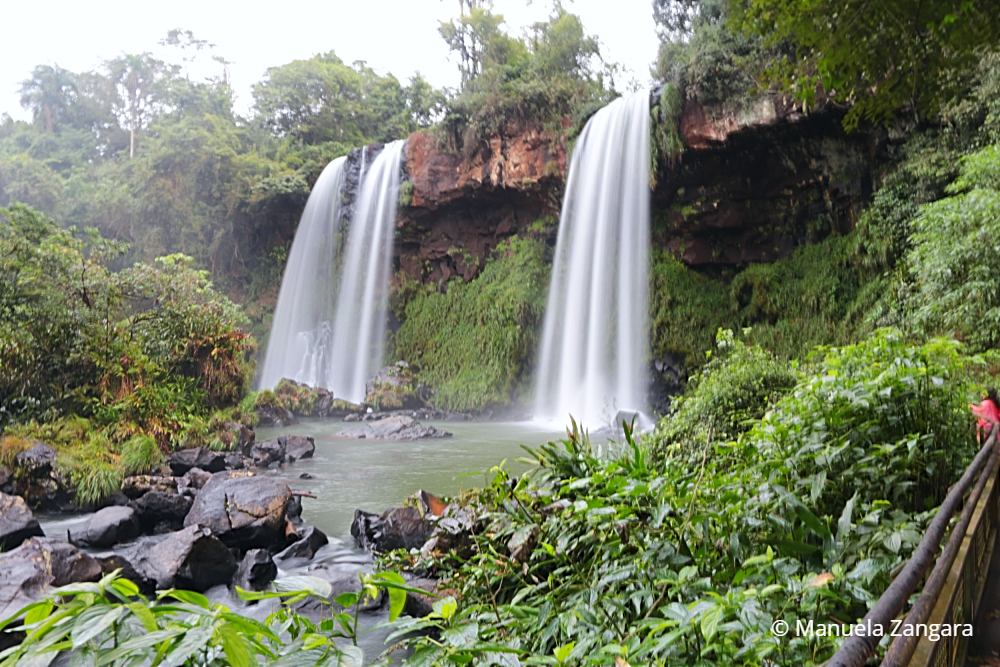
The next day (12th of June), we visited the Brazilian side of the Iguazu Falls. To visit this part of the park, half a day is enough, as it is smaller than the Argentine side. Being smaller, however, doesn’t mean less impressive.
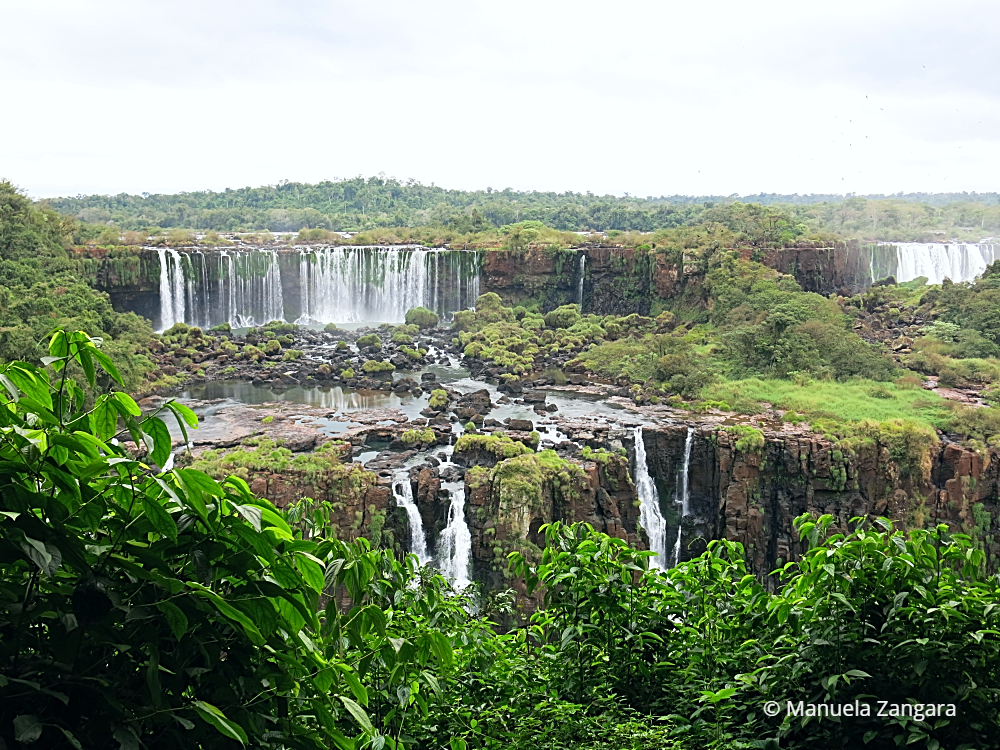
From this side, you get a panoramic view of the falls.
At the end of the path, you arrive in front of the Garganta del Diablo. The weather was gloomy and it started pouring! But as soon as the sun came out, we got to see a beautiful rainbow!


After the visit to the falls, we went to the Bird Park just in front. This is another beautiful experience.
Among the many birds, there are flamingos.

Macaws.

Toucans.

And even hummingbirds.

The following day (13th of June), we took a plane to Salta. We picked up the car we had rented and drove to our hotel: Balcon de la Plaza, right next to the main square.
We immediately went for a walk and we visited the San Francisco church (so pretty!).

San Bernardo Convent – only from the outside, as it is a cloistered convent.

The Cathedral and Cabildo on the main square.


The next day (14th of June), we started on our week-long road trip. After fixing our flat tyre, that is. We drove from Salta to Purmamarca, left our stuff at our accommodation – Cabañas Colores de Purmamarca – and then drove on to Salinas Grandes. To get there, you need to drive up a mountain on a winding road called Cuesta del Lipan that reaches 4170m above sea level!

Salinas Grandes is one of the largest salt plains in the world! And it is beautiful! You can even drive on it with your own car (and a guide).


After that, we went back to Purmamarca for the night.
The following day (15th of June), we explored the Quebrada de Humahuaca and its beautiful rock formations and little villages.
First, we went to Hornocal, near Humahuaca, to see the spectacular Cerro de los 14 Colores (aka the Mountain of 14 Colours). The road to get there is gravel but in good conditions. It takes about 40 minutes to get there from Humahuaca, but it is absolutely worth it.
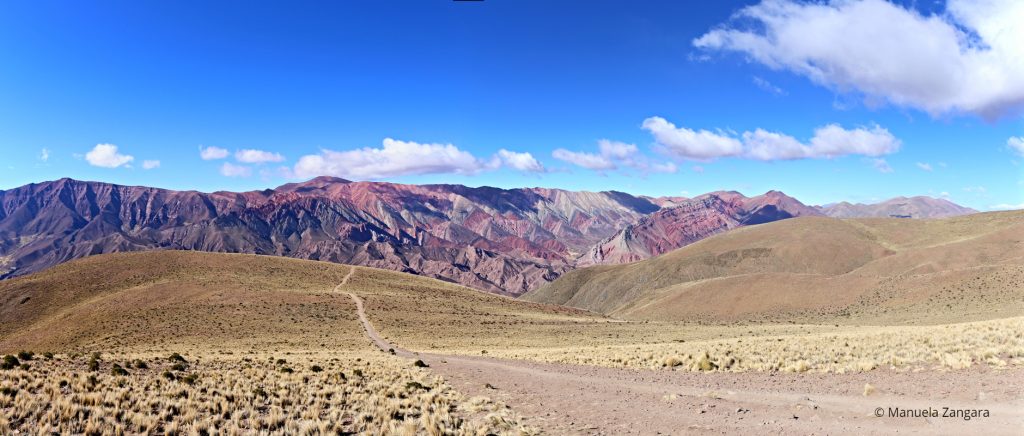
The mountain – which is at 4350m above sea level – is breathtaking.
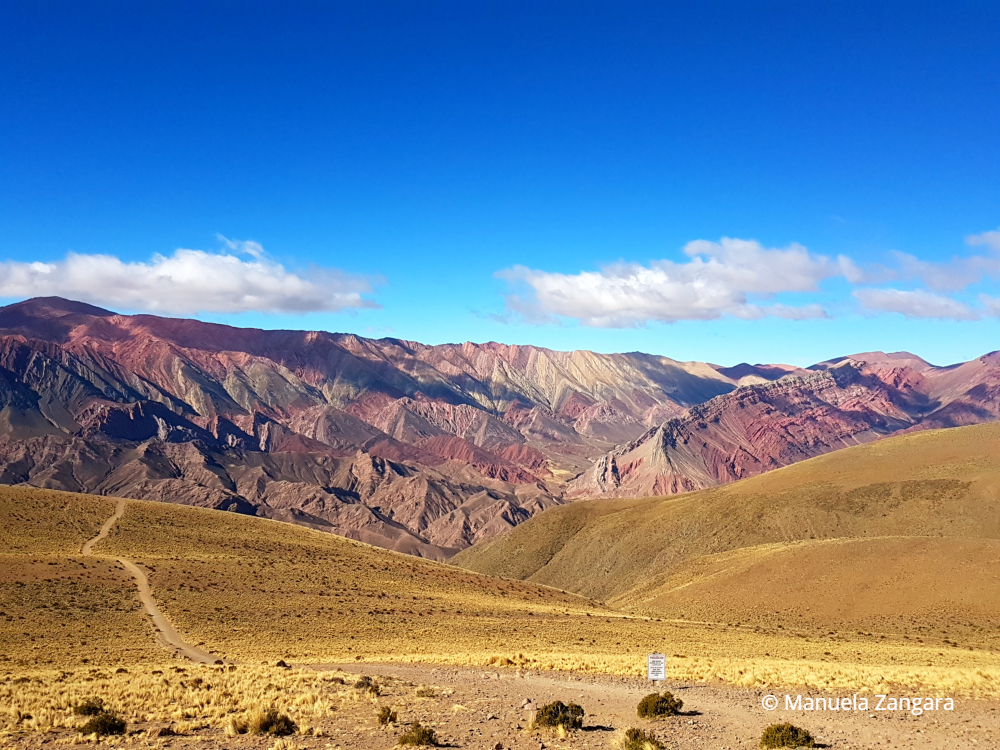
Then we visited the town of Humahuaca.


And drove back down towards Purmamarca, stopping at the various sites along the way.
The first main stop was to visit the Pukara of Tilcara – a little pre-Incan archaeological site on a hill overlooking the town of Tilcara.

Then, before going back to Purmamarca, we went to Maimara to see the Painter’s Palette.
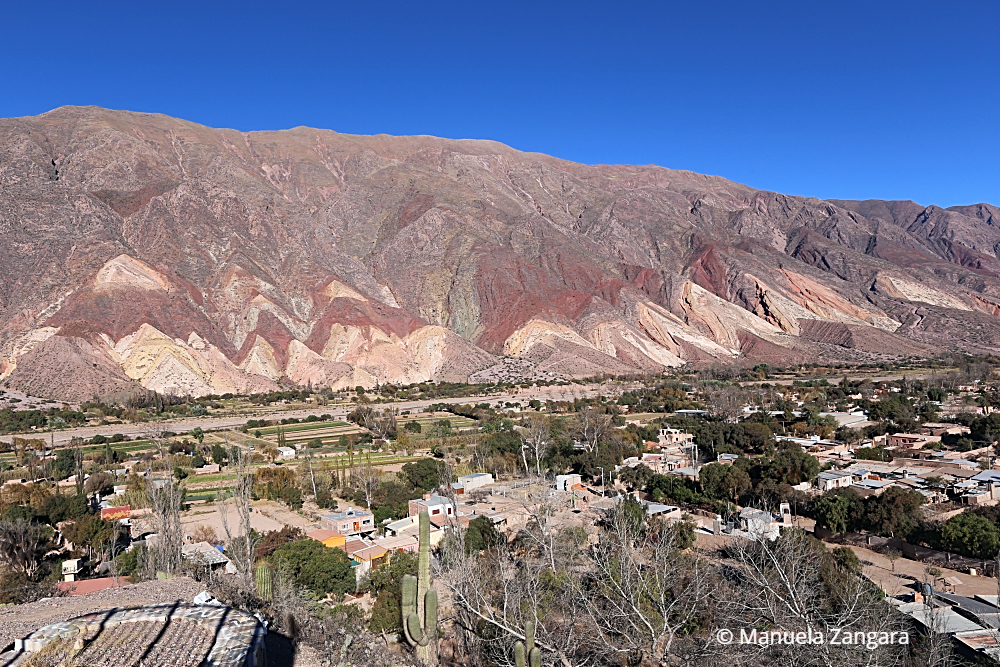
The best panoramic view is from the local little cemetery. Isn’t it amazing?

The next day (16th of June), we finally visited Purmamarca itself. We had a walk around town.

And did a little shopping at the local artisanal market.

Then we went up the mirador to see the Cerro de los 7 Colores (aka the Mountain of 7 Colours).

Besides the mountain itself, you can see the whole village from the hill!

Then we drove back to Salta for the night and we got to see a folkloristic show at one of the peñas in town. The girls loved it!

The following day (17th of June), we drove all the way to Molinos. To do that, we first drove up la Cuesta del Obispo.

Then through Los Cardones National Park, where we saw wild vicuñas roaming around!!

Lots of cacti!

And drove on the Recta del Tin Tin – a beautiful straight road!

After that, we arrived in Cachi – such a beautiful quaint colonial village!

After a short coffee break, we continued on a very bumpy gravel road all the way to Molinos, another pretty colonial village, our destination for the night. We stayed at Hacienda de Molinos, a beautiful historical house.
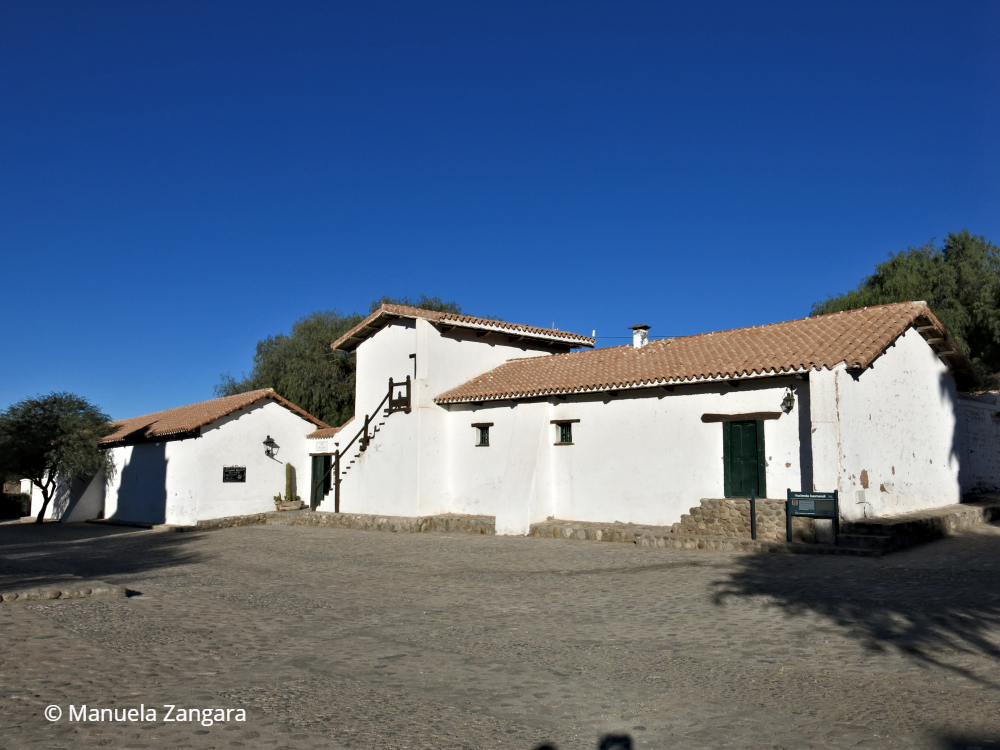
The next day (18th of June), we drove on an even bumpier road to Cafayate through the beautiful rock formations of Quebrada de las Flechas.
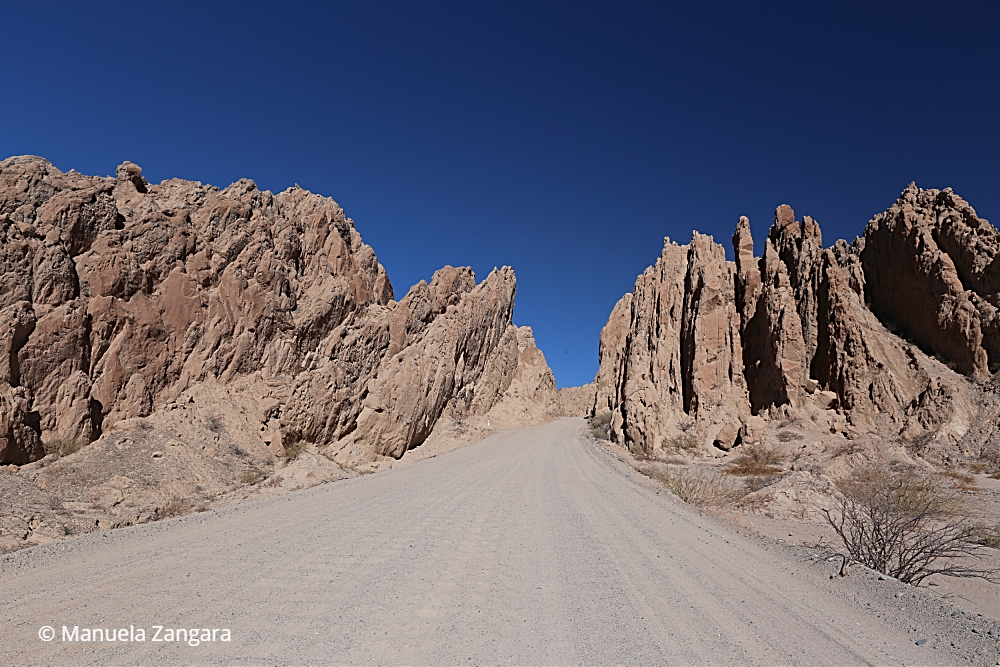

Cafayate is a little town, famous for its wine. The area is especially known for its Malbec (red wine) and Torrontes (white wine) production.

The town itself is very characteristic as well.

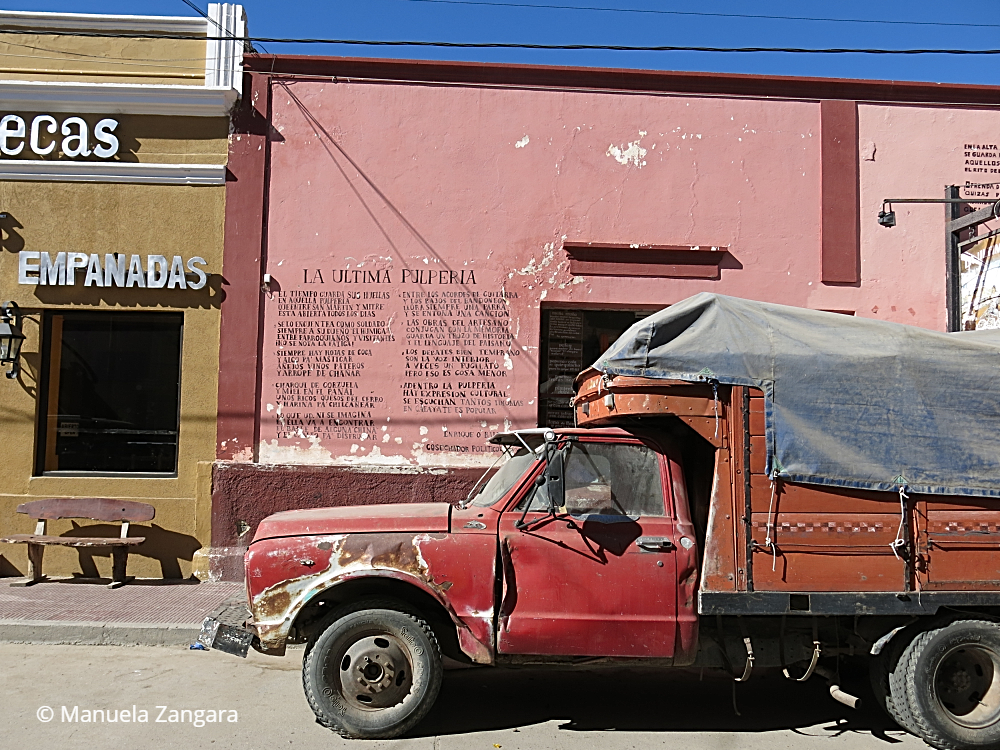
We spent 2 nights at Patios de Cafayate hotel, which is just next door to Bodega Esteco, a fine winery (which we also visited that afternoon).
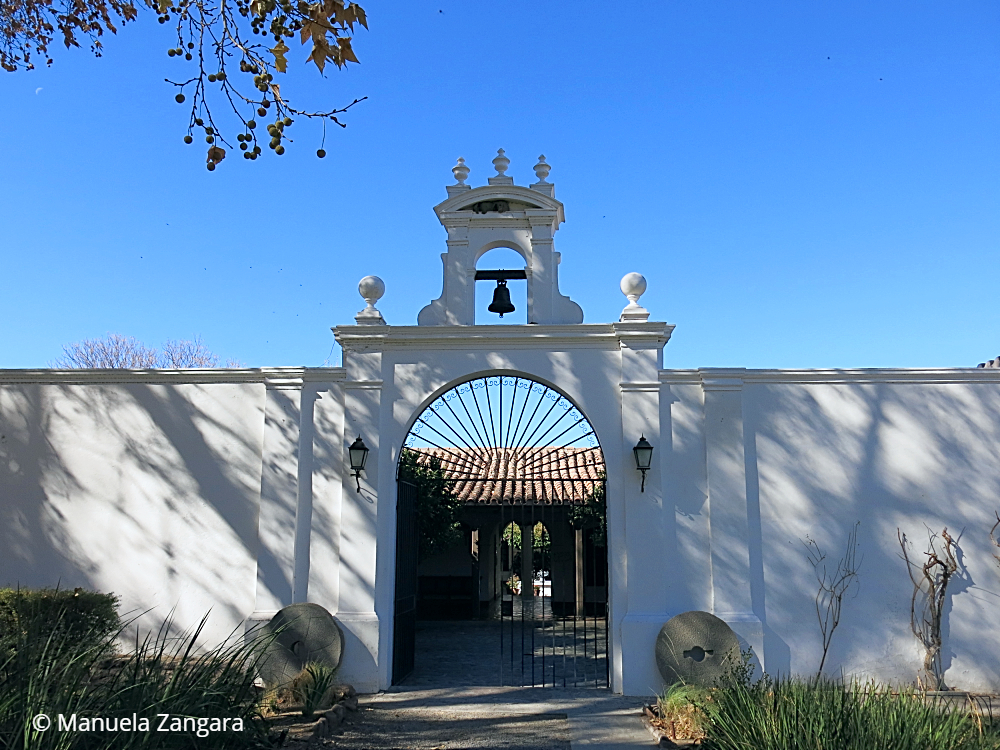
The following day (19th of June), we drove down to visit the pre-Incan ruins of Quilmes. The site is knowns as the little Macchu Picchu, because of its terraces.

The ruins are similar to the ones of Tilcara, however, the site is much bigger. There is also a little museum that is a gem. I highly recommend this visit.

On the 20th of June, we drove back to Salta through Quebrada de las Conchas. This place is absolutely stunning. It looks a bit like the Monument Valley in the USA, only much less touristic. We were almost always completely alone to enjoy this wonder.

Among the many rock formations, we got to see Las Ventanas (the Windows).

And the Amphitheatre, where the acoustic is as good as in Teatro Colon, the most famous theatre in Buenos Aires.
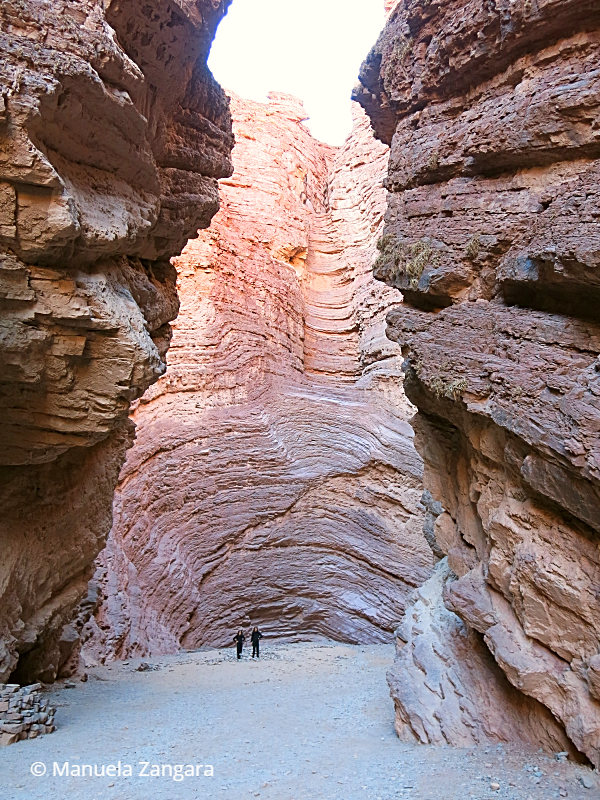
We also stopped at Mirador las 3 Cruces.

Then we dropped off our rental car and went to Finca Valentina, our accommodation for the night.
The next day (21st of June), we fly to Buenos Aires, where we stay 5 nights at the Hilton in Puerto Madero.
We immediately went walking to Plaza de Mayo to see Casa Rosada.

We arrived on a Thursday and, like every Thursday afternoon for the past 41 years, the Mothers of Plaza de Mayo (las madres) were there to demand justice and to remind everyone of the fact that 30,000 people were killed and made disappear during the dictatorship. The remains of many of these people are still to be found.

I have been a supporter of their fight since I can remember, so meeting them and talking to them was really moving for me.

Then we went to Café Tortoni to warm up with a cup of tea.
We spent the next few days walking around this amazing city and visiting the various sites like the Obelisk.

Avenida 9 de Julio with its 16 lanes (!!) and the building with Evita Peron’s images.
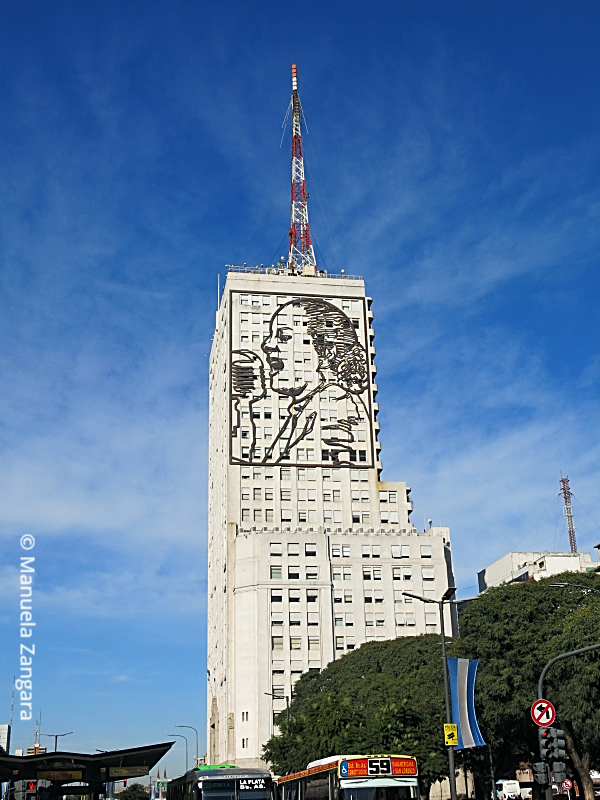
Caminito and its colourful houses.


The Recoleta area and its Cemetery with Evita Peron’s grave.
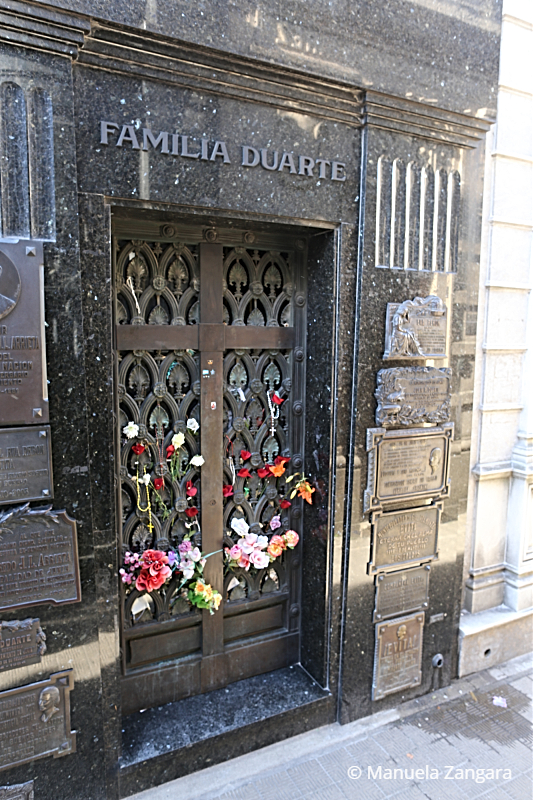
The shopping area of Calle Florida and Galerias Pacifico where we saw people dancing tango.

San Telmo with its market and fair.

Puerto Madero.

I will write much more about Buenos Aires in a specific post, but suffice it to say that we all fell in love with this city. It is just plain beautiful architecturally speaking (some areas look exactly like Paris) and it’s got a heart, a soul that makes it warm and makes you feel at home from the moment you land. We will definitely be back!
On the 26th of June, we left and went back to Santiago de Chile where we had just enough time for a quick visit to the Cementerio General. This was yet another moving visit. We first saw musician and singer Violeta Parra’s grave and the memorial to the people that were made disappear during the regime of Augusto Pinochet.
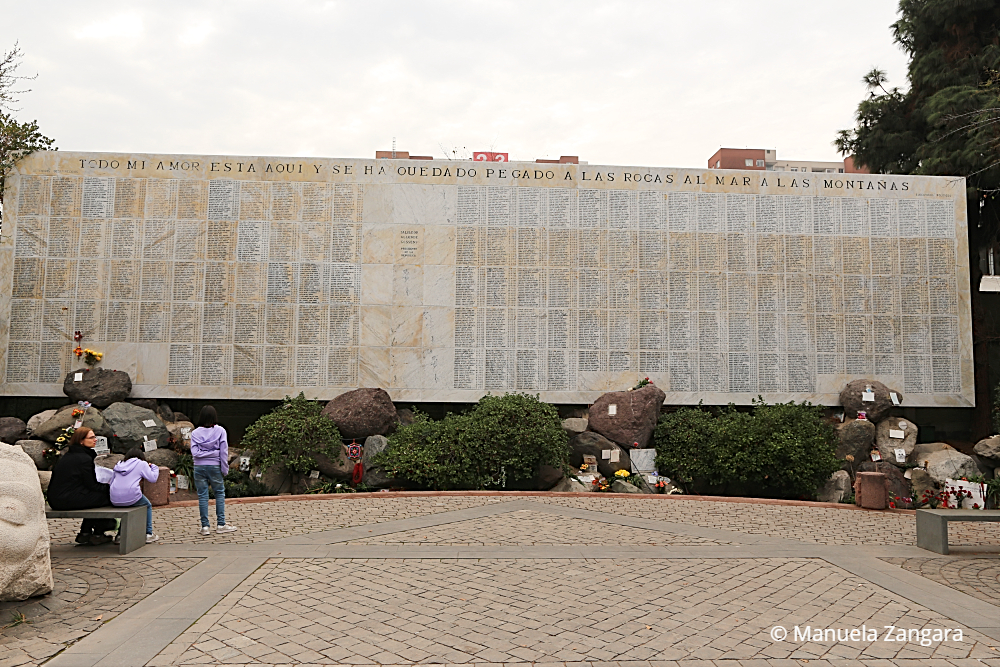
Then we paid our respect to Victor Jara, one of my favourite singers.

We walked to Patio 29, a common grave where political prisoners who “disappeared” during the 1973 Chilean coup d’état were buried anonymously.
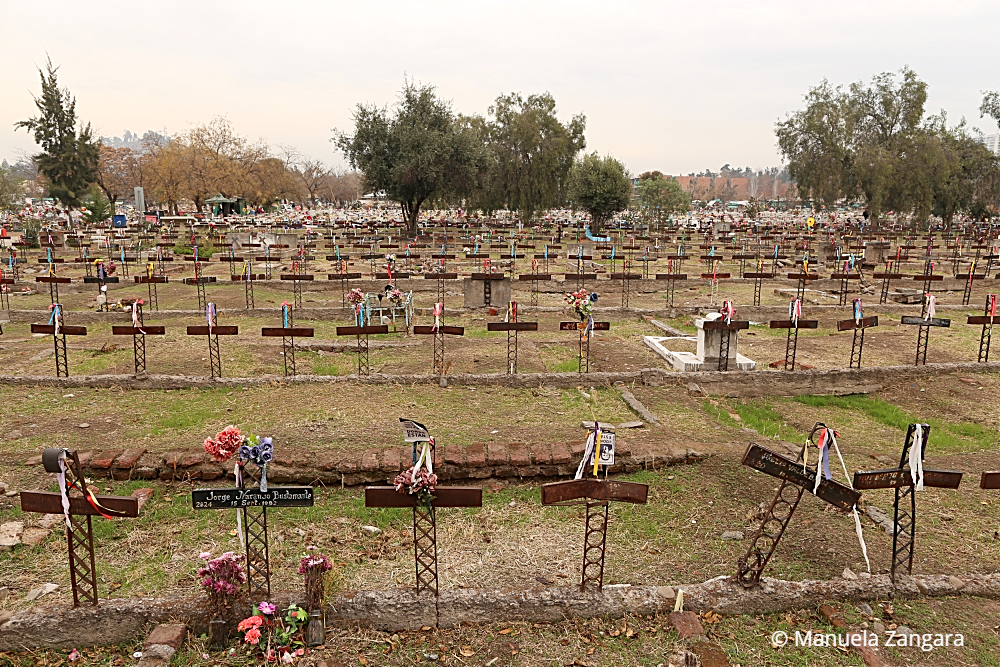
Lastly, we saw president Salvador Allende’s grave and mausoleum.

Then we went back to La Moneda, to finish from where it all began. We had booked a guided visit of the interior of the palace and it was amazing. I highly recommend it if you have any interest in history at all. I will share all the details on my Santiago de Chile guide.
The next morning (27th of June) we left our accommodation in Lastarria with a Transvip transfer and flew back to Sydney. The flight left at 1:30 PM and arrived in Sydney at 6 PM the following day (28th of June).
CONCLUSION
Needless to say, we LOVED it. It was a dream come true! We got to experience what we wanted and so much more. If you are looking for a destination that has breathtaking scenery and that is similar to Peru and Bolivia, close to the Andes, with delicious hearty food and wine, warm welcoming people and a relaxed pace, but less touristy than the surrounding countries, then this is the trip for you. And if you like history, well… what are you waiting for? Go and enjoy this emotional journey.
As for us, we will be back… and next time it will be to visit Patagonia and Tierra del Fuego.
If you have any questions, leave a comment and I will be happy to help out!
RESOURCES ON MSM
RECIPES:
Sopaipillas con Pebre y Pasadas
[mailerlite_form form_id=1]
